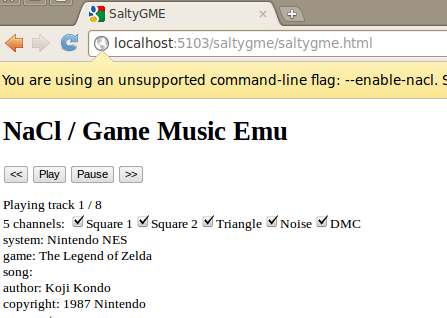After I posted about my initial encounter and frustration with Google’s Native Client (NaCl) SDK and took a deep breath, I realized that I achieved an important proof of concept– I successfully played music using the NaCl SDK audio output interface. Then I started taking a closer read through the (C-based set of) header files and realized I might be able to make a go of it after all. I had much better luck this time and managed to create a proper Native Client interface that allows for controlling playback, presenting metadata, and toggling individual voices (a fascinating tool for studying classic game music).
I haven’t bothered to post the actual plugin because, really, what’s the point? I started with NaCl SDK 0.3 which requires Chrome 12, which means terribly limited reach, even among Chrome users. At least, that was true when I restarted this little project. Chrome 12 was formally released this past week. Chrome development really does move at breakneck pace.
Anyway, here is a static screenshot of what the plugin currently looks like:

Not pretty, but it does the job.
Dev Journal
Various notes based on this outing:
- Portability: I tested my plugin using Chrome 12 on 64-bit Windows, Mac, and Linux. Mac and Linux both work; Windows does not.
- Build System: SDK 0.3 is still lacking in its ability to compile .cpp files (instead of .cc files); necessary because libgme is C++ using .cpp files. This requires some build system modification.
- Getting the interfaces: This is where I got tripped up the first time around. get_browser_interface() from their example actually refers to a parameter passed in through the PPP_InitializeModule() function. The SDK’s template generator renames this to get_browser().
- Debugging: I feel unstoppable once I have a printf() mechanism available to me during development. To that end, console.log() from JavaScript outputs to Chrome’s built-in JavaScript console log while putting printf() statements in the actual NaCl plugin causes the messages to show up in ~/.xsession-errors on Linux/X.
- Size Matters: The binaries generated with the NaCl 0.3 SDK are ridiculously huge. The basic “Hello World” example in C compiles to binaries that are 6.7 MB and 7.8 MB for the 32- and 64-bit builds, respectively. This made me apprehensive to build a full version of SaltyGME that contains all the bells and whistles offered by the library. However, all of the GME code compiled into the binary adds very little size. Curiously, the C++ version of “Hello World” only ranges from 1.8-2.0 MB for 32- and 64-bit. Is there some kind of C tax happening here? Note that running ‘strip’ on the resulting .nexe files (they’re ELF files, after all) brings the sizes down into the C++ range, but at the cost of causing them to not work (more specifically, not even load).
- No Messaging: The NaCl SDK is supposed to have a messaging interface which allows the NaCl plugin to send asynchronous messages up to the hosting page. When I try to instantiate it, I get a NULL. I’m stuck with the alternative of polling from the JavaScript side to, e.g., determine when a song has finished loading via the network.
That’s all I can think of for now. I may work on this a little more (I’d like to at least see some audio visualization). Maybe Google will enable NaCl per default sometime around Chrome 21 and this program will be ready for prime time by then.
See Also:
Interesting, though I was thinking that this probably uses little enough CPU that running it through the C-to-JavaScript compiler might make more sense…
See emscripten.org in case you’re not aware of it.
@Reimar: Yeah… http://jsspeccy.zxdemo.org/jsmodplayer/
I was thinking it would be more practical to convert the library to ActionScript (see Adobe’s Alchemy package) so the music and visualizations can be delivered as Flash.
I would have said that with emscripten you’d also cover a certain range of Apple products if it weren’t for the fact that the samples seem to crash the browser on the iPad at least… :-)
Chrome 14 has this set as on by default, so you may want to give it another shot- I’d like to see if you can get something you’re happy with here.